Top News
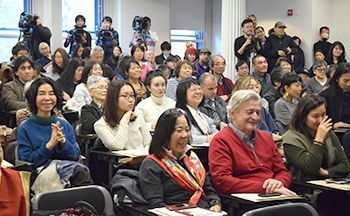
November 13, 2018 Ryukyu Shimpo
By Special Correspondent Yukiyo Zaha
For the first time following taking office, Governor Denny Tamaki chose New York as his first stop in the U.S. About 140 people gathered for his speech in which he said, “Okinawa’s diversity is a person like me; women who emigrated to the U.S. after marrying a U.S. soldier; children who were passed down the Okinawan soul from their parents; and the many soldiers and civilian personnel that have been stationed in Okinawa. I want people to take this diversity and drive a democracy that takes pride in further diversity.”
He also called out to the audience to start a wave of change to prevent the new base construction in Henoko, Nago City by beginning to take action in New York, “The City of Diversity.”
Governor Tamaki’s father is a former U.S. military soldier, while his mother is Okinawan.
He touched on his background and regarding Okinawa’s diversity, he said, “Okinawan citizens, while needing the strength to live, cannot afford to lose chimugukuru (the spirit/heart) and sincerity as their identity.
This is the soul that they take pride in.”
Regarding both the Japanese and U.S. governments forcing their way through with the construction of the new base, he said, “The doors to government and law are on the verge of closing.
We’re facing a harsh reality.” To break the deadlock in the current situation in which the will of the people is not being reflected, he said, “We want you (the U.S. citizens) to ask (the U.S. government) to deliver the pride of U.S. democracy to Okinawa.”
He thereby called on the citizens to urge this of the U.S. government.
When asked what he would like to accomplish while in office, he answered that his first order of business was preventing the new base construction in Henoko.
At the same time, he said, “I’d like to hold a women’s conference inviting Asia’s top leaders and the First Lady to Okinawa.”
Following this, there was a round of applause by the audience.
Seth Glossman, 48, who lives in New York said, “I hadn’t known much about the U.S. military bases in Okinawa or the environmental issues surrounding them. But today was a good experience. I would like to do what I can.”
Yoko Nakano, 42, who is from Okinawa and who used to live in New York during her school days said, “Continuation is key. There are many Okinawan people who think of Okinawa and want to contribute. It would be good to have Uchinanchu from around the world come up with ideas. If a women’s conference is to be hosted, then I’d like to see women get appointed to the prefectural offices.”
(English translation by T&CT and Chelsea Ashimine)
Go to Japanese
there in 30 years
November 11, 2018 Ryukyu Shimpo
At a meeting with Defense Minister Takeshi Iwaya, Okinawa Governor Denny Tamaki requested an end to shared use by Japan and the U.S. of the Fukuji Dam inside the U.S. military’s Northern Training Area and the Kanna Dam inside the U.S. military’s Camp Hansen.
This marks the first time that the Okinawa prefectural government has officially made a request to the national government to end shared use of a dam.
Pollution issues have arisen involving U.S. military munitions and bullets being discovered at dams in the shared use areas.
Residents also expressed concerns about water source contamination when a U.S. military CH53E large transport helicopter crashed on civilian land in Takae, Higashi Village in October of last year, as the site of the accident was close to the residents’ water source.
That accident was one impetus spurring Governor Tamaki’s present request.
According to a prefectural government source, no military training has been conducted at the dams in question since 1988.
However, the U.S. military is still permitted shared use of the dams.
If shared use ceases to be permitted, the U.S. military will no longer be allowed to train freely in these areas.
“[These dams] are an important water source for Okinawa’s main island. We hope the national government will respond by ending shared use so that Okinawans can use our water with peace of mind,” said Vice Governor Kiichi Jahana, who also attended the meeting.
(English translation by T&CT and Sandi Aritza)
Go to Japanese
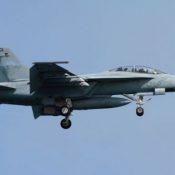
November 13, 2018 Ryukyu Shimpo
At about 11:45 a.m. on November 12, an F/A-18 fighter jet from Carrier Air Wing Five of the U.S. Navy Carrier experienced engine trouble and crashed in the ocean approximately 140 kilometers to the southwest of Minami-Daito Island, and approximately 290 kilometers east-southeast of Naha City.
The F/A-18 had taken off from the aircraft carrier USS Ronald Reagan, and was conducting joint U.S.-Japan flight training with the Self-Defense Forces when the accident occurred.
Two crewmembers ejected the F/A-18 and were rescued by a U.S. helicopter.
Following this the USS Ronald Reagan resumed its routine operations.
This marks the 50th U.S. military aircraft crash to take place in Okinawa since it was returned to Japanese sovereignty in 1972.
The site where the F/A-18 crashed appears to be within the airspace and waters of training zone Area Mike Mike.
According to the 11th Regional Coast Guard Headquarters, the U.S. military is scheduled to conduct training in Area Mike Mike up through November 30.
This training includes water-to-air, water-to-water and air-to-air target practice, and air-to-water bomb drop practice.
During this period fishing activities and entry into the Area are prohibited.
There has been no report of any damage to fishing boats or injury to civilians from the crash.
The Seventh Fleet of the U.S. Navy announced that the F/A-18 had experienced a “mechanical issue that resulted in the crew ejecting while conducting routine operations” in the Philippine Sea.
It also mentioned that Carrier Air Wing Five is onboard the USS Ronald Reagan, ensuring the safety and stability of the Indo-Pacific region.

Furthermore, it assured that the crash is being investigated.
On November 12, the Ministry of Defense (MOD) reported the incident to concerned municipalities such as the Okinawa Prefectural Government and Minami-Daito Village.
The MOD also proposed thorough enforcement of recurrence preventative measures to the Safety Administration of the U.S. Forces, Japan.
Upon being contacted by the Okinawa Defense Bureau, the Okinawa Fishery Radio Association and municipalities used the fishery communications systems to spread information about the crash.
F/A-18 aircraft frequently fly into Kadena Air Base and Futenma Air Station.
Domestic and international F/A-18 accidents occur.
One such plane crashed in the waters off Kochi Prefecture in December 2016, from which the pilot died.
In April 2017 an F/A-18E crashed attempting to land on the nuclear-powered aircraft carrier USS Carl Vinson, while the aircraft carrier was en route to the Korean peninsula.
Two pilots died from an F/A-18F crash in Florida this March.
This June in Okinawa, an F-15 fighter aircraft from Kadena Air Base crashed in the waters outside Naha.
In December 2016, an MV-22 Osprey vertical takeoff and landing transport aircraft from Futenma Air Station crashed off the coast in Abu, Nago City.
There have also been incidents of U.S. military aircraft dropping parts onto populated areas, taking emergency landings, and going up in flames.
Such incidents raise the sense of danger felt by Okinawans.
(English translation by T&CT and Erin Jones)
Go to Japanese
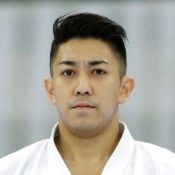
November 12, 2018 Ryukyu Shimpo
On the fifth day of the World Karate Championship held in Madrid, Spain, Okinawan-born Ryo Kiyuna (Ryueiryu-ryouho Kai, Konan High School and Okinawa International University) won his third-straight championship, defeating his Spanish opponent 5-0 in the final. Kiyuna ran roughshod over the competition, not losing a single point in any match on his way to the title.
In addition, on the final day of the tournament, November 11, Kiyuna also won the male group kata category along with teammates Arata Kinjo from Okinawa (Ryueiryu-ryouho Kai, Technical High School, and Okinawa International University) and Takuya Uemura from Naha (Ryueiryu-ryouho Kai, Konan High School and Okinawa International University), defeating Spain 5-0 for their second-straight title.
Kiyuna is the first Karate-ka to win his third-straight championship in the individual competition since Kiyuna’s mentor and Okinawa Sports Association President Tsuguo Sakumoto did so 30 years ago.
Kiyuna said, “I am happy to have accomplished my goal of winning each match 5-0.
I thought I was able to use the crowd’s energy to pull it off.” This victory solidifies Kiyuna’s place at the top of the Karate world.
Arata Kinjo, who represented Japan as part of the repeat-champion group kata team said, “We put our hearts into showcasing the technique of the Ryuei style.
We are very thankful for everyone’s support.” Takuya Uemura added, “As always, we tried to express Okinawan Karate with our performance. I hope we can continue to improve.”
Kiyuna said of his two championships, “Both the individual and group competition were won 5-0. I think I am happy.
Starting from the fundamentals, I want to keep practicing and leveling up,” he said, expressing his desire to continue perfecting his craft.
While the individual kata competition will be held at the 2020 Olympics, the group kata will not.
(English translation by T&CT and Sam Grieb)
Go to Japanese
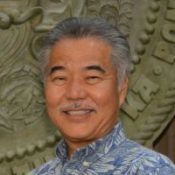
November 8, 2018 Ryukyu Shimpo
On November 6, third-generation Okinawan and incumbent Hawaii Governor David Ige (D) was re-elected in the gubernatorial election.
He received a total of 236,574 votes, a huge difference from the 109,857 votes received by State Representative Andria Tupola (R).
Ige was born in Hawaii in 1957.
His paternal grandparents are from Nishihara, and his maternal grandparents are from Yamaguchi prefecture.
Ige served as a state representative starting in 1985, and a state senator starting in 1994.
First elected as the Hawaii State Governor’s election in November 2014, Ige was the first person of Okinawan descent elected to a governorship in the United States.
Ige was the second person of Japanese descent elected as governor of Hawaii.
George Ariyoshi was the first, who served for three terms starting in 1974.
In this election Ige received more than 60% of votes, and won with a great difference from Tupola and other candidates.
Since taking office as governor, Ige has visited Okinawa twice, once in 2015 for the 30th-anniversary celebration of Okinawa and Hawaii becoming sister states, and once in 2016 for the 6th Worldwide Uchinanchu Festival. Ige built a close friendship with the late governor of Okinawa Takeshi Onaga, and actively promoted positive interactions between Okinawa and Hawaii in various fields such as the economy, culture, new energy development, and more.
(English translation by T&CT and Megumi Chibana)
Go to Japanese

November 1, 2018 Ryukyu Shimpo
On October 20 during the Japan Cheese Award held in Tokyo, the “Marinated Yomitan tyrí” cheese sold at Greek restaurant Little GREEK Kitchen in Nagahama, Yomitan Village won silver for the Fresh Variety category.
A different cheese from the same restaurant, “Yomitan tyrí” also won bronze in the Fresh Plain category. R
estaurant owner Pamela Ann smiled as she said, “Winning the awards makes me happy. I’m grateful.”
The Japan Cheese Award has been hosted every two years since starting in 2014.
Their purpose is to improve the quality of natural cheeses produced in Japan.
During this year’s competition, there were 233 entries from 78 shops from around the country.
A total of about 70 judges made up of producers and others participated.
During the first competition, a cheese from Hagoromo Farm in Okinawa won bronze.
Pamela, born in the U.S. and who had been working as a manicurist at the time, became interested in everything Greek after working for her Greek boss.
In 2016, she and her friend who lives in Okinawa established a Greek restaurant in Yomitan Village.
While feta cheese made with raw milk from sheep or goat is the norm in Greece, Pamela uses raw milk from cows reared at the Oyadomari Farm in Nanjo City to recreate the unique flavor of Greek cheese.
The “Marinated Yomitan tyrí” that won silver uses the “Yomitan tyrí” that won bronze and soaks it in Okinawan and/or Greek herbs, spices, and oils.
The word “tyrí” means cheese in Greek.
Pamela who has also lived in Greece for six years said, “Originally, I began making cheese for the children.
I also want the Okinawan people to appreciate the goodness of Greek things.”
Pamela is currently enrolled at a Greek university and does research on dairy products via video calls.
She voiced her interest in developing Camembert cheese and said, “Next time, I’d like to win gold. Good cheese can be made with Okinawan milk.”
(English translation by T&CT and Chelsea Ashimine)
Go to Japanese

November 9, 2018 Ryukyu Shimpo
On November 7, Okinawans descendants abroad issued “A Statement by Diasporic Okinawans in Support of Governor Denny Tamaki.” Governor Tamaki opposes the construction of the new military base in Henoko, Nago City, which is associated with the relocation of the U.S. military Futenma Air Station.
The statement was issued in preparation for the governor’s first visit to the U.S, which is to take place between November 11 and 15 local time.
The hope is to call on diasporic Okinawans to sign the petition online, which will lead to grassroots movements that may persuade the U.S. public opinion and government.
The petition was started by nine diasporic Okinawans, including Jane Yamashiro, Emma Tome, and David Kim. They also worked with diasporic Okinawans in South America to create English, Japanese, Spanish, Portuguese versions of the statement on change.org, a petition website.
An Uchinaguchi, or Okinawan dialect, version will later be posted. As of November 7, about 600 people have signed the petition.
One of the creators of the petition, New York University East Asian Studies Assistant Professor Annmaria Shimabuku explained the significance of the statement. She said, “(The statement) appeals to the historical memory and reality of ordinary Uchinanchu around the world.
It tries to deepen the concern about the new Henoko base construction.” She also added, “Uchinanchu abroad, who felt that Okinawan issues and military base issues have been restricted by right or left ideologies, were encouraged by Governor Tamaki, who has a diverse background, and are now able to get involved. We hope to start a movement that says, ‘No to Henoko.Don’t underestimate Okinawa.’”
The statement emphasizes that “the overwhelming will of the people who oppose the plan to construct the new Henoko base holds significant meaning” in Okinawa, which is politically divided regarding the existence of U.S. military bases.
The statement also introduced the words by the previous Governor Takeshi Onaga, who had said that what is important is “Identity Not ideology.”
The statement also points out, “The fact that Denny Tamaki is the first mixed-race governor in Japanese history is a watershed moment since mixed-race individuals and their Okinawan mothers have often been negatively associated with the bases”
(English translation by T&CT and Chelsea Ashimine)
Go to Japanese

November 3, 2018 Ryukyu Shimpo
Motobu – The Motobu town government, which recently rejected a quay use application renewal for trucks loading dirt and sand as part of Henoko land reclamation work, confirmed on November 2 that a number of the quays in the Shiokawa section at Motobu Port had been damaged by a typhoon.
The quays’ concrete has broken and caved in, and there are parts where the ballast has been exposed.
Town officials have said, “Repairing the quays within the year will be difficult,” and noted that the repairs would take months to complete, delaying the dirt and sand loading.
Motobu Port was hit by Typhoon No. 24 at the end of September, and the damage to the port still remains, rendering three of the six quays unusable.
Regarding the rejection of the quay use application, Motobu town mayor Takeyasu Taira stressed, “The application was rejected after local and prefectural employees surveyed the current situation.”
The company loading dirt and sand for use in land reclamation at Henoko requested that they, “would still like to be able to use the quays despite the damage,” when submitting their quay use application November 1.
However, town officials reaffirmed their policy stating, “the renewal is not accepted,” and explained that the application was rejected due to reasons including the risk of causing additional damage by using the damaged quay, and the negative effects this would have on repair costs.
Currently, the three quays that are still usable are being utilized for purposes other than new base construction.
According to Motobu town officials, there are already 45 other quay use applications for the Shiokawa section of the port that have also been rejected.
The town government once again explained, “It is impossible for us to grant any licenses in the current situation.”
(English translation by T&CT and Sam Grieb)
Go to Japanese

November 7, 2018 Ryukyu Shimpo online edition
On November 7, the Okinawa Defense Bureau (ODB) moved forward with installing floats on the ocean as part of construction of the Futenma replacement facility in Henoko, Nago City.
Citizens who oppose construction of this facility went out before 8:00 a.m. on two protest boats and twelve canoes to object to the installation of these floats.
The orange floats are being gradually laid out in the water of Oura Bay, and now stretch to about 100 meters from the already-constructed K9 seawall to the north.
Protestors in canoes commented that once connected to shore the floats will make getting close to the actual construction site difficult, which in turn will make protest activities more difficult.
Those in the canoes stayed close to the yet-to-be-connected end of the floats, and protested the new floats being set up and keeping them from shore.
Citizens called out, “Through the gubernatorial election the people of Okinawa have shown that we do not want a base built in these waters; understand these sentiments.”
US Osprey were seen repeatedly landing and taking off over the ocean, which was crowded with work ships and Japan Coast Guard inflatable boats.
(English translation by T&CT and Erin Jones)
Go to Japanese
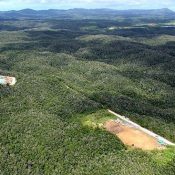
November 3, 2018 Ryukyu Shimpo
By Yuri Shimizu
On November 2, the Japanese government decided to resubmit nomination of an Okinawan site for United Nations Educational, Scientific and Cultural Organization (UNESCO) World Natural Heritage status.
The site is comprised of Amami Oshima, Tokuno Island, a northern part of Okinawa Island, and Iriomote Island (hereafter referred to as Amami-Okinawa).
Chief Cabinet Secretary Yoshihide Suga held a press conference the same day to announce the decision.
Suga said that Amami-Okinawa nomination is being resubmitted because the site is very likely to be granted World Natural Heritage status.
This is because Natural Heritage items are being given priority and the International Union for Conservation of Nature (IUCN), as an advisory body to UNESCO, has previously assessed the site.
The government plans to pass this decision through the Cabinet and submit a nomination file to the UNESCO World Heritage Centre by February 1 next year.
It is expected that the IUCN will conduct its field inspection next summer or autumn, and that the World Heritage Committee will make a decision on World Natural Heritage status at its meeting in summer 2020.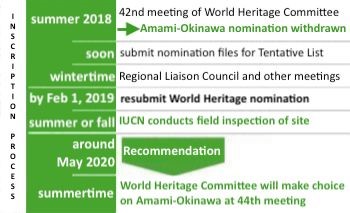
The Amami-Okinawa site satisfies selection criteria in terms of having a high level of biodiversity, and being a habitat of threatened species.
This site has competition for next year’s nomination from a Cultural Heritage site in Japan on the Tentative List: the Jomon Archeological Sites in Hokkaido, Northern Tohoku, and Other Regions.
Nominations are limited to one World Cultural or Natural Heritage site per country, so whether or not Amami-Okinawa’s nomination will be resubmitted is a point of focus.
Japan hoped to have the Amami-Okinawa site included on the World Natural Heritage list this summer.
However, in May the IUCN recommended deferral and requested revision to some contents of the nomination file.
This made incorporation on the World Natural Heritage List unlikely, so in June the nomination was withdrawn.
Information on NTA Land Decontamination
Japan has decided to resubmit nomination of the Amami-Okinawa site for inclusion on the World Natural Heritage List.
UNESCO policy requires that Japan make one nomination for Natural or Cultural Heritage.
Because Natural Heritage is being prioritized, the Amami-Okinawa site is likely to overcome domestic barriers to nomination.
However, many of the issues that the IUCN pointed out with the nomination remain.
One of the main reasons for the IUCN’s deferral was that portions of the U.S. military Northern Training Area (NTA) returned in December 2016 were not included in the government’s nomination file, so in June Japan moved to incorporate Yambaru National Park into the nominated site.
These portions are to be included in the IUCN’s field inspection planned for next summer.
According to the Okinawa Defense Bureau (ODB) unexploded bombs, debris, and soil pollution were detected on the returned NTA land even after decontamination work.
There is concern over what experts will say about the returned land’s environment during inspection.
The IUCN recommended that Japan cooperate with the U.S. military to manage nature conservation on NTA land that has not been returned to Okinawa, and yet no new agreements have been forthcoming.
Time is limited for Japan to submit its nomination file to UNESCO.
It must do so within the next three months.
If the nomination is not incorporated onto the World Natural Heritage List in 2020, it will cast doubt on future incorporation.
Japan has come to a critical juncture as it aims for certain incorporation of a site on the World Heritage List.
(English translation by T&CT and Erin Jones)
Go to Japanese
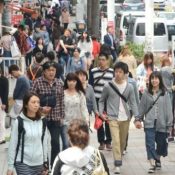
November 3, 2018 Ryukyu Shimpo
By Ryota Nakamura
Reports of Okinawa’s tourism surpassing that of Hawaii’s for the year 2017 had become a trending topic. However, The Hawaii Tourism Authority revised the total number of visitors it received up to 9,404,346, consequently overtaking Okinawa’s visitor count of 9,396,200. The HTA released a tentative figure of 9,382,986 in February, seemingly falling behind Okinawa by 13,214 visitors. In reality, Hawaii had welcomed 21,000 more visitors during the year than initially reported, exceeding Okinawa’s figures by 8,146. The prefecture’s dreams of outperforming Hawaii in tourism remains elusive.
In Okinawa, the total number of tourists received is reported by fiscal year as well as the January to December calendar year. Number of visitors for the 2017 calendar year was announced in January of this year.
On the other hand, the HTA says it releases a tentative figure in January or February the following year, announcing its official count in the fall. Although the 2017 figures released on Feb. 1 were not yet finalized, Japanese media outlets including the Ryukyu Shimpo reported Okinawa’s tourism as having exceeded Hawaii’s, placing a spotlight on the story.
The HTA responded to our request for comment, stating that these figures are revised every year. “An accurate head count is not always reported when flights are delayed or cancelled,” and the tentative numbers are therefore subject to change.
Given the earlier reports, Okinawa had been promoting its tourism as having surpassed Hawaii. Marketing schemes will continue to brand the prefecture as on par with the popular resort destination.
Nevertheless, the prefecture’s growth rate in tourism between 2016 and 2017 was 9.1 percent, compared to that of Hawaii’s at 5.3 percent. Since tourism in Okinawa continued to trend upwards in 2018, it remains to be seen whether 2018 will finally be the year Okinawa surpasses Hawaii.
(English translation by T&CT and Monica Shingaki)
Go to Japanese












 Webcam(Kokusai Street)
Webcam(Kokusai Street)


